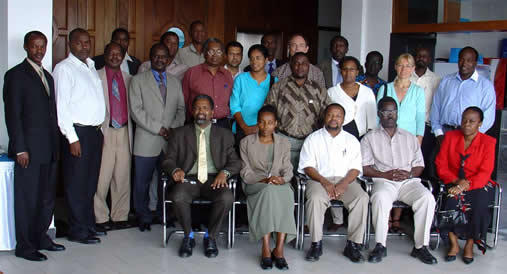Pigtrop - Le centre d'information sur l'élevage porcin et les filières porcines des pays du Sud
- Renforcement des compétences de recherche
- Formation technique
- Expertise et conseil
- Réseaux
- Veille bibliographique
- Support éditorial
CWGESA | network on cysticercosis
Agricultural researchers and social scientists join medical and veterinary doctors to combat an emerging neglected zoonosis in Sub-Saharan Africa
General presentation
Pig keeping and pork consumption in the Eastern and Southern Africa (ESA) Region have increased significantly during the past decade, especially in rural smallholder communities, primarily due to the lack of grazing land for ruminants and the recognition by farmers of a quicker and more impressive return on their investment from raising pigs. In addition, the increased demand for pork in urban areas of the region has resulted in the transportation of pigs from these rural smallholder communities to large population centres. Unfortunately, due to conditions related to poverty such as inadequate sanitation, poor pig management practices and lack or absence of meat inspection and control, cysticercosis caused by the zoonotic pork tapeworm Taenia solium has emerged as an important constraint for the nutritional and economic well-being of these smallholder farming communities. In addition it is also emerging as a serious public health risk not only in these rural communities but also in the urban areas where many infected pigs are transported and consumed.

Recognising the agricultural and potential public health impact of cysticercosis, the regional nature of the problem, and the scarcity of resources for investigating and combating the problem, scientists actively conducting research on cysticercosis in ESA recently formed a regional working group to increase awareness of the problem and help promote and coordinate research and control activities for T. solium . The Cysticercosis Working Group in Eastern and Southern Africa (CWGESA) is currently composed of members from universities and research institutes in Kenya, Uganda, Tanzania, Zambia, Zimbabwe, Mozambique and South Africa.
Last year the CWGESA concluded that the evidence thus far collected by the group concerning the cysticercosis situation in the region was of such a scale that the information should be urgently shared with relevant persons at the regional and international levels to instigate the interest, will and support for further baseline studies on the situation in both pigs and humans as well as surveillance, prevention and control efforts in ESA. In cooperation with colleagues at the WHO/FAO Collaborating Centre for Parasitic Zoonoses in Denmark, the Danish Bilharziasis Laboratory, and the DANIDA-funded ENRECA Livestock Helminths Research Project in Eastern and Southern Africa, the CWGESA decided to hold an international workshop on cysticercosis/taeniosis caused by T. solium . Considering the availability now of very effective tools for diagnosis, treatment and prevention of T. solium and the designation of cysticercosis as one of only a very few infectious diseases deemed eradicable by an international task force, there is certainly the potential that control efforts will pay-off if organised carefully. A regional approach to the situation is to be promoted to make more effective and efficient use of scarce resources.
The CWGESA considered holding an International Action Planning Workshop on Taenia solium cysticercosis/taeniosis with special focus on eastern and Southern Africa. Workshop discussions included a review of the status of cysticercosis/taeniosis caused by the zoonotic pork tapeworm, Taenia solium , in different regions of the world, with special emphasis on the emerging situation in eastern and southern Africa, where it is becoming a serious economic problem and public health risk. Tools now available for diagnosis, treatment, prevention and control were presented as well as strategies for mobilising and managing resources needed for research, surveillance, prevention and control of the parasitic disease. Potential linkages and partnerships with ongoing related activities at the local, regional and international level were also discussed and strategies for communicating the problem and its control to different target groups were highlighted.
This workshop resulted in the formulation of an appropriate and sustainable Action Plan for a regional programme for research, surveillance and control of cysticercosis/taeniosis caused by T. solium in Eastern and Southern Africa (ESA) with an overall objective to increase awareness and improve human health and well-being, pig production, the domestic food supply and export opportunities for pork in ESA and elsewhere by developing and implementing an appropriate and sustainable surveillance, prevention and control programme for cysticercosis caused by T. solium . This is very timely in that the actions outlined can be linked with several on-going related activities at the regional and international level including:
- New Global Initiative on Epilepsy "Out of the Shadows" led by World Health Organisation (WHO) and the international epilepsy associations
- Reconvening of the International Task Force for Disease Eradication by the Carter Center, USA with funding from the Gates Foundation
- New Food and Agricultural Organization (FAO) Veterinary Public Health Initiative in Developing Countries funded by DFID
- Inclusion of Neurocysticercosis on the agenda of the 2002 World Health Assembly
- Interest in development of a regional initiative directed at improving the health and production of pigs in resource-poor rural areas of Sub-Saharan Africa
Commentaires
CIRAD © 2007 (Tous droits réservés) - Informations légales - Page mise à jour : 14/05/2007
